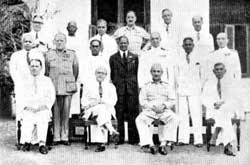The
great reformer of education
The 'Father of Free Education,’
C. W. W. Kannangara was born 122 years ago in
the month of October. He was born on October 13,
1884. It has been universally accepted that no
other Minister has done more for the promotion
of education in Sri Lanka. His proposal to let
a child have his or her education from kindergarten
to university without paying a cent was indeed
a revolutionary concept. No wonder he had to go
through with it in the teeth of bitter opposition
from the socially and economically privileged
groups including several of his senior political
colleagues.
 |
| As a member of the Board
of Ministers, C. W. W. Kannangara (third row
second from left) was a member of the War
Council set up in 1942 during World War II.
|
The legislation to end fees for
tuition from school to university was introduced
by him as Minister of Education in the pre-independence
State Council when the Executive Committee system
was in operation. The move turned out to be one
of the earliest social welfare schemes in Sri
Lanka.
In addition to free education,
during his 17-year period of service as Minister
of Education, he initiated extensive reforms.
The two-tiered school system with English for
the privileged classes and vernacular for the
rural masses was abolished. He introduced the
mother tongue as the medium of instruction and
reformed the curriculum with a vocational and
cultural bias. Pirivena education was upgraded
and the university was inaugurated. He was instrumental
in establishing a series of Central Schools (Madya
Maha Vidyalayas) modelled on Royal College. These
took secondary education to the doorstep of the
rural student and developed over the years to
become the foremost educational institutions in
the outstations.
Christopher William Wijekoon
Kannangara (1884-1969) was born in Ambalangoda
and completed a brilliant school career at Richmond
College, Galle. He became a teacher and first
taught at Richmond and later at Wesley College.
He then took to law, setting up his practice in
Galle in 1910. His involvement with martial law
victims drew him into national politics and he
entered the Legislative Council in 1923 by winning
a bye-election for the Southern Province seat.
He won the elections that followed and was elected
to the State Council in 1931 and 1936. It was
ironical that after he established free education,
he was defeated at the first Parliamentary election
in 1947. He then served as Ambassador in Indonesia
and returned to win the Agalawatte seat in 1952
and become Minister of Local Government and Housing. |
